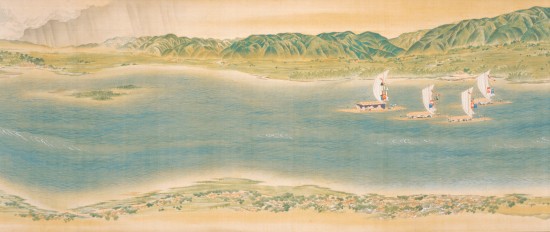From Hara Museum ARC, Gunma
Landscape of Yodo River by Maruyama Okyo (1733-95) was featured on September 4th in the special series of the Nihon Keizai Shimbun “Bi no Bi” column entitled “Super View—Edo Painting/A Visual Adventure (Part 1)”. The author of the column was Tadashi Miyagawa.
Yodo River, a widely known work in the Hara Rokuro Collection, is a long scroll painting that Maruyama Okyo created in his early 30s. The painting, which depicts the scenery on the banks of the Yodo River from Fushimi in Kyoto to Tenmabashi in Osaka, spans a length of approximately 16 meters.
Okyo is credited with establishing a style of “realism” which merges the objects depicted, such as mountains and rivers, with the actual space of the viewer. The present work is one step in the evolution of that style.
His representation of space is characterized by a unique perspective and visual sense by which the progression of scenes on both banks appear from above and below with the river in the center. The result is a quirky visual experience for the viewer. This is described in detail in the article, which is highly recommended.

Maruyama Okyo, Landscape of Yodo River(detail), hand scroll, Edo period, 1765
The minuteness with which he painted the scenery is truly stunning. We urge you to take a close look at the surprising detail in the people living on the river banks and the mountain ranges.
Maruyama Okyo “Landscape of Yodo River” will be on view during the dates indicated below. Different scenes will be shown in Part 1 and 2 of the exhibition.
——————————————————-
◆Shapes of the Seasons
Part I : October 28 (Fri.) – November 30 (Wed.), 2011
Part II : December 2 (Fri.), 2011 – January 4 (Wed.), 2012
Kankai Pavilion (traditional East Asian art)
Hours: 9:30 am – 4:30 pm *last entry 30 minutes before closing
Closed: Thursdays (except November 3, December 29), January 1
*Closed temporarily in the event of severe weather.
Admission: General (over 12) 1,000 yen; children (over 3) 500 yen; 10% discount for a group of 20 or more.
*Children must be accompanied by an adult
**Combination ticket for Hara Museum ARC and Ikaho Green Bokujo ranch: General 1,800 yen; Children 900 yen
Getting There: By train: Take the Joetsu Shinkansen to Takasaki, change to the Joestu Line, and disembark at Shibukawa. From Shibukawa, ARC is 10 minutes away by taxi or 15 minutes by bus (take the Ikaho Onsen bus to “Green Bokujo Mae”). By car: 8 kilometers (about 15 minutes) from the Kan-etsu Expressway Shibukawa Ikaho Interchange (in the direction of Ikaho Onsen).
——————————————————-
ACCESS
By Train
By JR Joetsu・Nagano Shinkansen
Recommended timetable
・10:12 Depart Tokyo Station→11:01 Arrive at Takasaki Station/ 11:11Depart Takasaki Satation→11:35 Arrive at Shibukawa Station
・11:12 Depart Tokyo Station→12:03 Arrive at Takasaki Station/ 12:20 Depart Takasaki Satation→12:44 Arrive at Shibukawa Station
・12:24 Depart Tokyo Station→13:14 Arrive at Takasaki Station/ 13:31 Depart Takasaki Satation→13:56 Arrive at Shibukawa Station
By JR Joetsu Limited Express Kusatsu
・ 9:00 Depart Ueno Station→10:37 Arrive at Shibukawa Station (No.31 ; operates only on Saturdays, Sundays and holidays)
・10:00 Depart Ueno Station→11:43 Arrive at Shibukawa Station (No.3 ; operates only on Saturdays, Sundays and holidays)
・12:00 Depart Ueno Station→13:45 Arrive at Shibukawa Station (No. 5)
From Shibukawa Station, take the Kan-etsu Kotsu Bus and get off at the station “Green Bokujo Mae.” http://www.kan-etsu.net/r-bus/timetable/shibu-ikaho-1.htm (in Japanese only). ARC is about 7 minute walk from the bus station.
By Car
Take the Kan-etsu Expressway to Shibukawa Ikaho Interchange. Go in the direction of Ikaho Onsen for 8 km (about 15 min.) .
Highway information:
E-NEXCO Drive Plaza http://www.driveplaza.com/ (in Japanese only)
<website> http://www.haramuseum.or.jp
<mobile site> http://mobile.haramuseum.or.jp
<Twitter> http://twitter.com/#!/HaraMuseumARC
